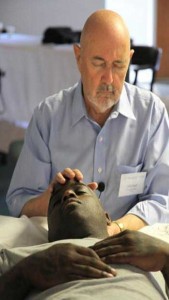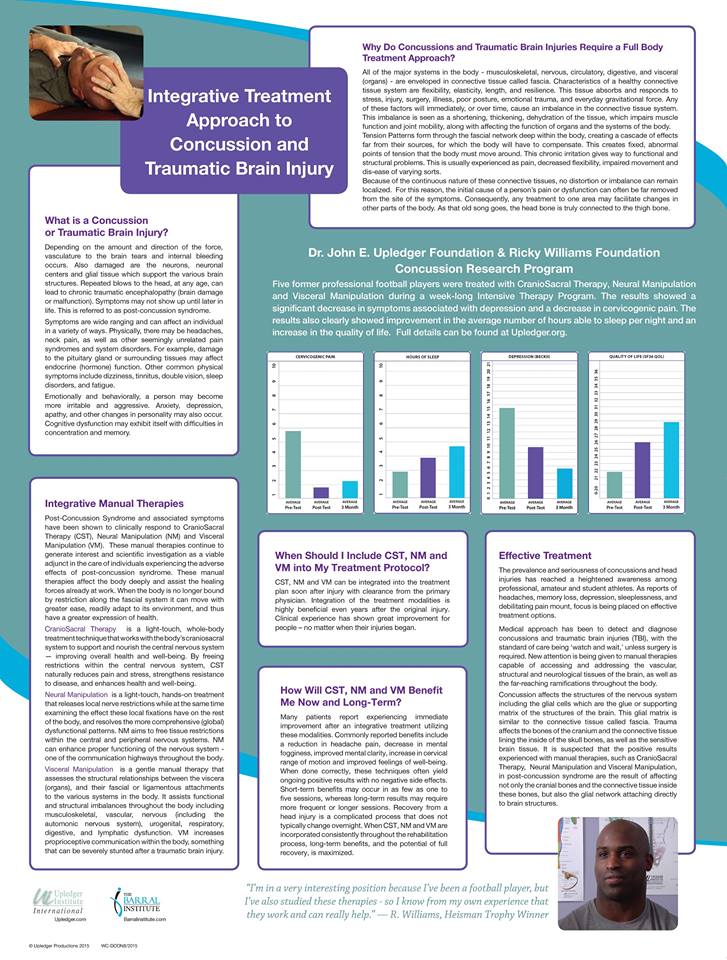The Upledger Foundation and the Ricky Williams Foundation are continuing their research into how Craniosacral Therapy helps football players.

Integrative Treatment Approach to Concussion and Traumatic Brian Injury
Post-Concussion Syndrome and associated symptoms have been shown to clinically respond to Craniosacral Therapy and integrative bodywork. These manual therapies continue to generate interest and scientific investigation as a viable adjunct in the care of individuals experiencing the adverse effects of post-concussion syndrome. These manual therapies affect the body deeply and assist the healing forces already at work. When the body is no longer bound by restriction along the fascial system it can move with greater ease, readily adapt to its environment, and thus have a greater expression of health.
Why do concussions and traumatic brain injuries require a full body treatment approach?
All of the major systems in the body – musculoskeletal, nervous, circulatory, digestive and visceral (organs) – are enveloped in connective tissue called fascia. Characteristics of a healthy connective tissue system are flexibility, elasticity, length and resilience. This tissue absorbs and responds to stress, injury, illness, poor posture, emotional trauma and everyday gravitational forces. Any imbalance is seen as shortening, thickening, dehydration of the tissue, which impairs muscle function and joint mobility along with affecting the function of organs and the systems of the body. Tension patterns form through the fascial network deep within the body, creating a cascade of effects far from their sources for which the body will have to compensate. This creates fixed, abnormal points of tension that the body must move around. This chronic irritation gives way to functional and structural problems. This is usually experienced as pain, decreased flexibility, impaired movement and dis-ease of varying sorts.
Because of the continuous nature of these connective tissues, no distortion or imbalance can remain localized. For this reason, the initial cause of a person’s pain or dysfunction can often be far removed from the site of the symptoms. Consequently, any treatment to one area may facilitate changes in other parts of the body.
Effective Treatment
The prevalence and seriousness of concussions and head injuries has reached a hightened awareness among professional, amateur and student athletes. As reports of headaches, memory loss, depression, sleeplessness and debilitating pain mount, focus is being placed on effective treatment options.
Medical approach has been to detect and diagnose concussion and traumatic brain injuries with the standard of care being “watch and wait,” unless surgery is required. New attentionis being give to manual therapies capable of assessing and addressing the vascular, structural and neurological tissues of the brain, as well as, the far-reaching ramifications throughout the body.
Concussion affects the structures of the nervous system including the glial cells which are the glue or supporting matrix of the structures of the brain. This glial matrix is similar to the connective tissue called fascia. Trauma affects the bones of the cranium and the connective tissue lining the inside of the skull bones, as well as the sensitive brain tissue. It is suspected that the positive results experienced by manual therapies such as Craniosacral Therapy and others in post-concussion syndrome are the result of affecting not only the cranial bones and the connective tissue inside these bones, but also the glial network attaching directly to brain structures.

Source: Upledger.org
